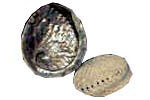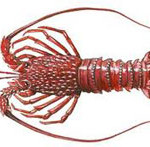
of the species Polysteganus undulosus, Petrus rupestris, Chrysoblephus cristicepsand C. gibbiceps
Seabream or porgies are members of the Sparidae family of carnivorous bony fishes. Porgies are carnivores of hard-shelled benthic (bottom dwelling) invertebrates. Many species have been found to be hermaphroditic; some have male and female gonads simultaneously. Others change gender as they get larger.
The structure of the fins of Porgies is essentially the same as in the family Serranidae of seabasses with which they can be confused. There are important anatomical differences, however, most obvious of which are that the edge of the gill cover does not end with a sharp spine in the porgies but is rounded or at most bluntly angular; and that the maxillary bone (the bone forming the margin of the upper jaw) is sheathed and hidden when the mouth is closed. Long, pointed pectoral fins (found on each side of the body behind the gill opening) are likewise characteristic of the family; the spiny and soft portions of the dorsal (back) fin are continuous, and the soft-rayed anal fin is about as long as the soft part of the dorsal. There are over 40 species of seabream to be found in the region, but there are four endemic species in particular that we would like your help in surveying:
The seventy-four Seabream (Polysteganus undulosus) is found over rocky reefs and banks of deep waters. It is a carnivorous species that feeds mainly on fish and squid. It can grow to 120cm. At one time abundant, this elegant fish has become scarce in recent years. The flesh is highly prized. The name is supposedly derived from lines on the body resembling rows of gun ports along the sides of the old “seventy-four” manof-war.
The red steenbas (Petrus rupestris) is the largest of the Sparidae occurring in southern African waters, growing to 200cm. It is a solitary territorial fish inhabiting rocky banks in coastal waters and estuaries. It feeds on octopus, crabs and fish. The elongated, robust body is light red to bronze, and in some specimens there are beautiful, yellow undersides. The fins, especially the pectorals are a darker red. The red steenbas has a slightly extended snout, and a bony ridge between its eyes, which is particularly evident in larger fish.
The daggerhead seabream (Chrysoblephus cristiceps) grows to 75cm and can be found over rocky banks at depths ranging down to 100m. It feeds on crustaceans, molluscs, worms, and small fishes
The red Stumpnose (Chrysoblephus gibbiceps), has a very localised distribution, being found only from Cape Town up to East London. It can grow to 75cm. It is noticeably deep-bodied, and has a very steep forehead that is slightly concave below the eyes. In older male fish, the upper forehead develops a bulbous projection that becomes increasingly spongy and pitted with age. The snout is somewhat pointed and the body is silvery-pink overall, but darker above. There are 5-7 darker-red, vertical bars on the sides of the body. These are also numerous dark blotches on the body, particularly the upper flanks. This is another solitary species, inhabiting offshore reefs to depths of 150m. The strong teeth help dismember the hard-shelled animals in a diet comprising molluscs, marine worms, sea urchins, octipuses, smaller fish and crabs.








Social Profiles